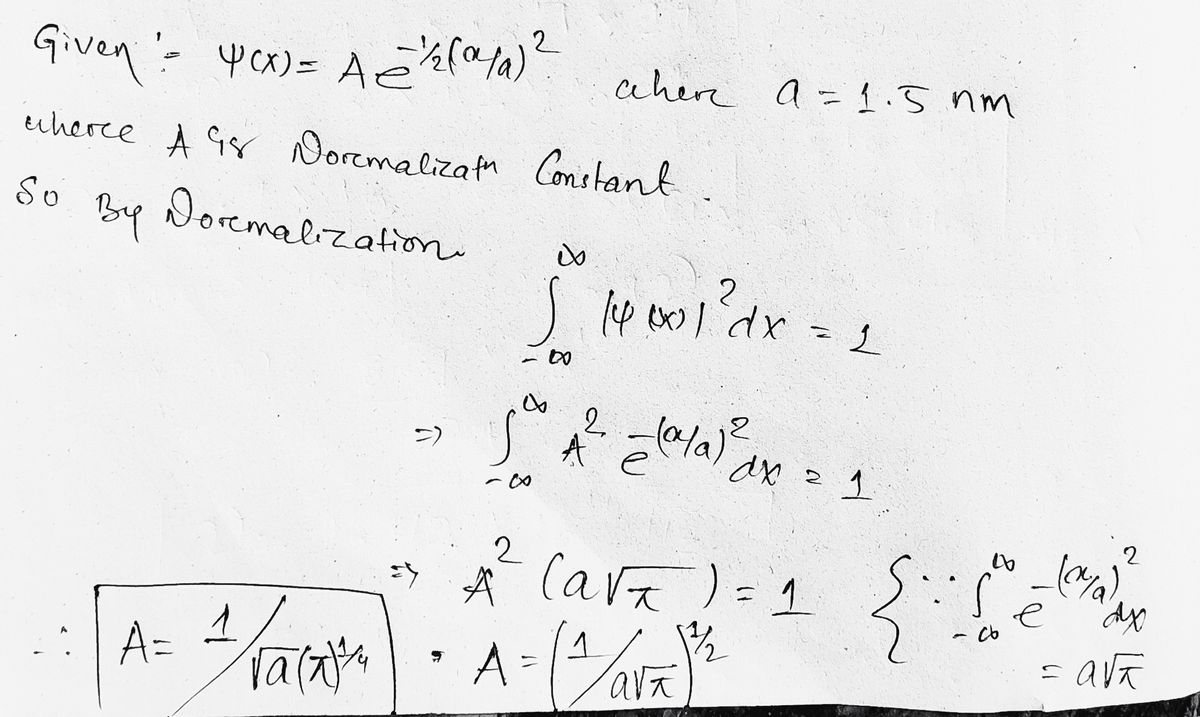- Suppose a quanton's wavefunction at a given time is y(x) = Ae-(x/a)², where A is an un- specified constant and a = 1.5nm. According to the table of integrals |_*_*[e={{x/a)²]dx = a√ñ 102 If we perform an experiment to locate the quanton at this time, what would be the proba- bility of a result within +0.1nm of the origin? (Hint: Note that 0.1 nm is pretty small com- pared to the range over which the exponential varies significantly. You should not therefore have to actually calculate and integral.)
- Suppose a quanton's wavefunction at a given time is y(x) = Ae-(x/a)², where A is an un- specified constant and a = 1.5nm. According to the table of integrals |_*_*[e={{x/a)²]dx = a√ñ 102 If we perform an experiment to locate the quanton at this time, what would be the proba- bility of a result within +0.1nm of the origin? (Hint: Note that 0.1 nm is pretty small com- pared to the range over which the exponential varies significantly. You should not therefore have to actually calculate and integral.)
Related questions
Question
please explain on paper thank u I will like
![### Understanding Quantum Wavefunctions
**Wavefunction Description:**
Suppose a quanton's wavefunction at a given time is
\[
\psi(x) = A e^{-\frac{1}{2}(x/a)^2}
\]
where \(A\) is an unspecified constant and \(a = 1.5 \, \text{nm}\).
**Integral Calculations:**
According to the table of integrals:
\[
\int_{-\infty}^{\infty} \left[e^{-\frac{1}{2}(x/a)^2}\right] dx = a \sqrt{\pi}
\]
---
**Probability within a Specified Range:**
If we perform an experiment to locate the quanton at this time, what would be the probability of a result within \(\pm 0.1 \, \text{nm}\) of the origin?
*(Hint: Note that 0.1 nm is pretty small compared to the range over which the exponential varies significantly. You should not therefore have to actually calculate an integral.)*
---
This explanation deals with the integral of a Gaussian function, which is crucial in understanding quantum mechanics and probability amplitudes. The hint helps students conceptualize probability without necessarily performing a calculation, by recognizing the negligible probability over a small range in comparison to the function’s significant spread.](/v2/_next/image?url=https%3A%2F%2Fcontent.bartleby.com%2Fqna-images%2Fquestion%2F5b55a0fb-5dff-4587-97c0-c3ec381e9c7e%2F78acbd79-3810-47d4-8344-808ec5ee1070%2Focc1gil_processed.png&w=3840&q=75)
Transcribed Image Text:### Understanding Quantum Wavefunctions
**Wavefunction Description:**
Suppose a quanton's wavefunction at a given time is
\[
\psi(x) = A e^{-\frac{1}{2}(x/a)^2}
\]
where \(A\) is an unspecified constant and \(a = 1.5 \, \text{nm}\).
**Integral Calculations:**
According to the table of integrals:
\[
\int_{-\infty}^{\infty} \left[e^{-\frac{1}{2}(x/a)^2}\right] dx = a \sqrt{\pi}
\]
---
**Probability within a Specified Range:**
If we perform an experiment to locate the quanton at this time, what would be the probability of a result within \(\pm 0.1 \, \text{nm}\) of the origin?
*(Hint: Note that 0.1 nm is pretty small compared to the range over which the exponential varies significantly. You should not therefore have to actually calculate an integral.)*
---
This explanation deals with the integral of a Gaussian function, which is crucial in understanding quantum mechanics and probability amplitudes. The hint helps students conceptualize probability without necessarily performing a calculation, by recognizing the negligible probability over a small range in comparison to the function’s significant spread.
Expert Solution
Step 1: Calculation of normalization constant

Step by step
Solved in 3 steps with 3 images
